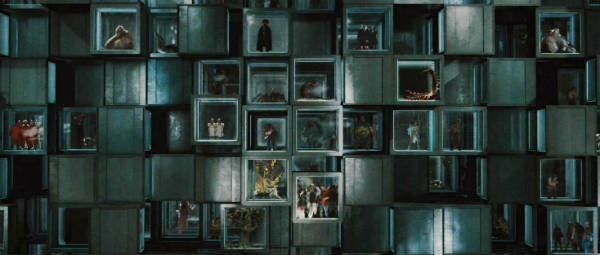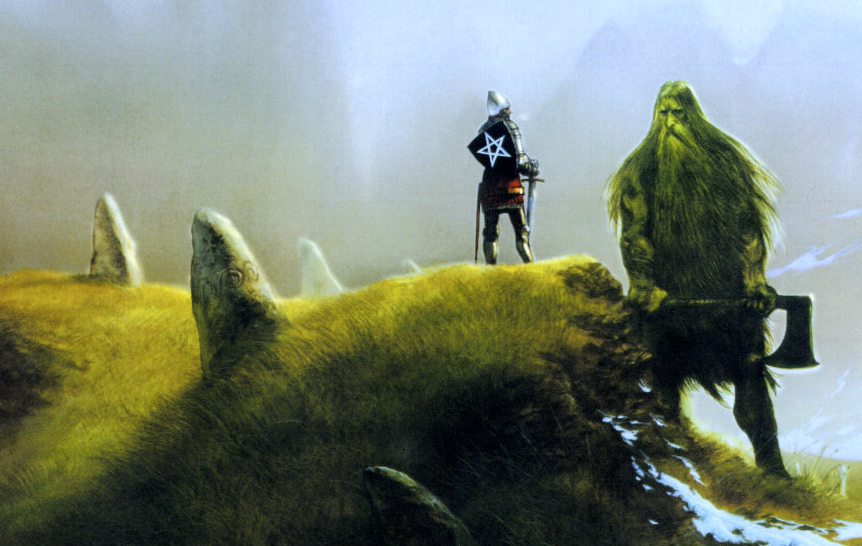I’m pretty sure the first rashomon I ever saw, at least the first where the on-the-fly construction of the story really set me back on my heels, was this one:
After that I was hooked. Completely. Forever. Happily. Now I keep a running list of rashomon stuff, which I’ll annotate below some. But it also strikes me that every single first-person story is basically being told as ‘counter’ to the version that ‘really’ happened. Yes? Or undercutting it, embellishing it, fleshing it out—taking whatever rhetorical strategy is necessary for our estimation of this narrator to be ‘good’ rather than ‘bad.’ I mean, in the stories that are obviously rashomon, each character’s version of events is that wonderful kind of selecting an offense that anticipates the defense, yes? From Nick Carroway to Patrick Bateman, there’s not a single narrator we can trust. And that indeterminacy, that’s where fiction lives. Without it the process of creating a narrative is really just stacking bulletpoints one after the next. Without self-aggrandizing selection, we’re left with the illusion of non-fiction. Which can be fun in itself—those are fertile grounds to lie in, if you can adopt the right ‘journalistic’ pose, and keep from grinning too obviously, and if you don’t get seduced by research or correspondence to facts or, though I hesitate, “truth”—but what I’m talking about here is conflict. That’s what’s at the heart of every rashomon. As readers, we know almost immediately that all of these versions can’t be the way it really went down. They’re not just wildly divergent, they’re so obviously self-serving. And that friction, it produces heat, and that heat it drives the story.
However, is there even a ‘way it went down?’ I’m looking at you, Verbal Kint. What I find endlessly fascinating and so, so productive with the rashomon is that ‘reality’ slips away, and all we’re left with, finally, is story. We have to judge what’s ‘real’ by the strength of the narrative alone, never mind any useless correspondence to evidence. Who cares about things you can tie toe tags onto. What really matters in the world, it’s story. Without narrative, none of us even have an identity, do we? Narrative is specifically how we manage to persist across time, instead of living moment-to-moment, like goldfish. The stories we manipulate and edit and tell about ourselves, they are ourselves. And it’s an ongoing process. Ask me who I am today, I’ll highlight these select events. Ask me tomorrow, it’ll be a different set of events. It’s the nature of existence, as near as I can tell. And the rashomon—not to reduce it to ‘just’ a means of survival—is a way to externalize that process. To condition and tone those muscles. To heighten our awareness of both the fragility of who we are and our endurance.
And, yes, if every first-person narration can be considered one ‘side’ of a hidden rashomon, then there’s more variants as well. Cabin the Woods, say. When they’re in the bad-idea cellar, unknowingly selecting the mechanism of their death? It’s a rarely beautiful moment, because at that point the movie splits, it branches into as many possibilities as there are unlockable ‘items’ in that room—as many corresponding ‘cells’ as there are in the underground bunker. Which is to say, the story splits into all these versions, and, while we’re busy following the “Zombie Redneck Torture Family” version, part of our minds are aware of the dim shapes lumbering alongside: there’s the death-by-unicorn version also happening, there’s the giant snake, there’s Kevin. And, yes, there’s even the mermaid.

A sophisticated-enough Choose-Your-Own-Adventure can do this as well, and so, so beautifully. I’ve only seen this happen in manuscript, but, when you make decision A on page 2, say, the story goes this way instead of that way, in time-honored fashion. But, what if that decision B you didn’t make, it becomes a sort of stalking horse alongside the narrative path you’re taking? And this continues with each decision, even the dead-end certain-death ones. ‘You’ the hero are always looking over the fence of your own narrative track, seeing the other stories running alongside; as David Foster Wallace would insist, the membrane is permeable. And those ‘other’/side stories themselves are acting like strange attractors, warping the story you’re in. It’s this weird result of conflicting versions that somehow cooperate, or are entangled at a quantum level. It’s pretty magic, really, and hard to pull off, but so worth trying (or, is Go already doing some version of this? is Run Lola Run? or are they each more drawing from that third-time’s-the-charm structure that’s been going on since Gawain?).

And I wonder if we could even consider ‘It was all a dream’-endings to have been, at some level, rashomons? At the end of The Wizard of Oz, there are two versions of what went down, and they can’t both have happened, right? Or is the ‘rashomon effect’ in these cases a way of doubling meaning, rather than dangling ‘truth’ before the reader, then pulling it away? Granted, not all ‘dream’ endings do that—some merely erase, disappointingly—but the ones that do, they tend to go wide, Life of Pi. Because the audience is getting double the bang for their buck: two stories from a single read. Two stories running alongside each other, and dipping in and out of each other’s track.
Is that the real strength of the rashomon? The same way subtext can make a discussion ‘matter,’ can make it deep enough to be actually interesting and revealing instead of just revealing information, does the rashomon add similar layers? Or is it just pointless narrative muddling, in lieu of a direct, easy-to-unfold story?
Me, I prefer being asked to choose. I like being put in the position where I invest here—no, here—until finally I don’t know who to root for, intellectually. And then I have to make a decision without my head. Which is exactly where I always want to be as a reader.
So, though this list is wildly incomplete and alarmingly light absent on fiction (is that just me, or are there not any rashomons on the page? am I not thinking of them? can’t imagine I haven’t read twenty), these are the good rashomons I’ve managed to crib down. But you’ll have more, and more, and probably better. Put them in comments, maybe? Because I want them, too. I need them.
Rashomon
Goes without saying that it all starts here. Or, really, with the story, right? (pdf of it. and, here’s six mins of Altman on Rashomon). And, while the rashomon has been done since with more humor and more complexity, I halfway suspect that it’s never actually been done better than this:
Hoodwinked
This is some really solid, fun storytelling. And note that “If you think you know the story” lead-in, and how it matches Cabin in the Woods‘ “You think you know the story…” With the rashomon, you never do. I haven’t seen the second Hoodwinked yet, so can’t say if it’s rashomon or not, but this first one is completely satisfying:
One Night at McCool’s
Reminds me of “Thirteen Ways of Looking at a Blackbird.” Reminds me of that title, anyway: everybody’s got their own version of this one woman. And, this time, maybe they’re all true.
Courage Under Fire
Not dissimilar to McCool’s, except the content here’s deadly serious: war. But—you know how in the early twentieth century there were so many Jekyll & Hydes? It’s because actors love to show off how they can be this, and they can be that (a feat Tatiana Maslany owns now and forevermore). For Courage, that’s what Meg Ryan’s doing: in this version she’s one character, and in the next she’s somebody completely different.
And, that’s all I’ve got written down, as far as movies go (I don’t remember 8mm well enough to say if it’s one or not). And I’m resisting the urge to search up everybody else’s surely-comprehensive lists. Even just from this small handful, though, what’s obvious are the basic components of the rashomon:
-
a ‘crime’—usually a victim, too. usually a victim who’s now silent? that does put the burden on the suspects . . .
-
multiple ‘guilty’ parties: nobody’s innocent, in spite of their so-convincing version
-
an investigator, be it cop or friend or bystander or whoever: somebody to ask questions
-
touchstones: events that all the versions hit (CYA always has this as well, yes?)
In Hoodwinked, that investigator is a frog, I think. But that’s all you need, really: a talking frog with bagful of question marks. I can even suspect that you could pull a legit rashomon off with just two ‘guilty’ parties (would Murder by Numbers be a twist on this? using the rashomon to create reasonable doubt?). And, whether the way it really happened is revealed in the end or not—that can go either way. Some stories leave us to decide (ambiguity, please, not just the vagueness of non-commital), and thereby make all these claims about ‘reality’ and ‘truth’ and all that, and some, Arlington Road-style, give us a reverse-cascade sort of infodump at the end. And both ways can work, too. That’s the cool thing. Just because you’re in a rashomon, you’re not guaranteed this or that type ending. Instead, you have to keep everything in a buffer pattern in your mind, a staging area in your head, only to be applied when that one insight is cued, that one golden key inserted that lights up the backpath, right to the heart of the crime.
It can be pretty cool. It can be about cooler than anything, really.
It happens on television pretty regular, too. Where I’ve seen it going on is:
-
X-Files 3.8, “Jose Chung’s From Outer Space“
-
Psych 7.14, “No Trout About It”
-
Supernatural 2.15, “Tall Tales”
-
The Simpsons, “Trilogy of Error” (“Homer’s thumb is cut off at breakfast and the episode follows three different paths”)
-
Star Trek Next Generation, “A Matter of Perspective”—of special note as it makes the rashomon ‘interactive,’ via the holodeck
But surely there’s some Buffy, right? And hopefully a Three’s Company episode as well. And all shows in-between. And, I guess, every single Law & Order since about 1990 (crime/investigator/versions & touchstones . . .). I have scribbled down in my notes a Mama’s Family episide, “Rasho-Mama,” which sounds suspiciously Kurosawa-ish, but I can’t recall having ever seen it (however, I watched them all first-run, so I’d guess I have, I just didn’t know what I was seeing). Wait, look, it’s here:
http://www.youtube.com/watch?v=glRc2J2igsI
And, wow: eighty seconds in, and we’ve got the guilty pool of soon-t0-be liars, we’ve got word of the ‘crime,’ and there’s an investigator there to ask the necessary questions, to prompt the three versions. Pretty efficient storytelling, yes? Maybe television’s a good place to study the rashomon. On television, there’s no time to dawdle: you dive right in. Novelists, take note.
Just poked around on-line a bit, too, seeing if I was just somehow missing the “Rashomon”-shelf at B&N, and: nope. All the discussions I can find are trying to cast House of Leaves as rashomon, and World War Z, and Sound and the Fury, and Pale Fire. All of which have that narrative undercutting and doubling/tripling/more we like with the rashomon, yes. And in WWZ there’s a journalist-as-investigator, even, and House of Leaves has its ‘investigator’ as well. There’s not that Agatha Christie ‘closed door’ feel to any of these, though. There’s not that distinct sense that one of us is definitely the perpetrator. And, for me, that closed-doorness, it’s vital—it’s specifically why I’m so into slashers, I think: red herrings abound, and are cut down just when the story starts to gel around them, and suddenly I’m launched forward into a different story, and then, ten minutes and a convenient decapitation later, a different story . . .
Couple of other likely contenders I found, novel-wise, thanks to Google: Wilkie Conkins’ The Moonstone, which I confess to never having read. And I’ll just paste this one:
Surreallist writer Raymond Queneau wrote a book called “Exercices de style” which is a brief description of an encounter at a bus stop told from 99 different viewpoints. Published in French in 1947, translated into English by Barbara Wright in 1958. [linkback]
Anybody read this? I hadn’t ever even heard of it. And, I’d so like to pull something like Peter Straub’s Ghost Story in, or Dan Simmon’s Hyperion—novels which are Canterbury-style: a group of people sitting around some version of a campfire, telling stories. Just, plant a dead body on page one, Christie-style, and, man, suddenly these stories are about wiggling out of blame, and we’re half the way there. And, if people are going to count HoL—I don’t—then a lot of the later PKD should count as well, I’d think; just because the ‘guilty parties’ are in the same head doesn’t make them any less culpable, does it? Maybe Identity should even somehow contribute here, though it’d be a peculiar ‘third-person’ kind of rashomon, with both a dislocated ‘investigator’ and a version of the ‘all-a-dream’ ending as well—maybe all to good effect, even. There’s no rule saying if you do a rashomon it has be the like this and this only. What kind of fun world would that be to tell stories in? Pick and choose what you will, I say. Find ways to undercut the form itself, if it tells a clean story. An emotionally engaging story. That’s always got to be the first goal, the prime directive of this many-year mission.
 And: comic books? The rashomon has to have happened on the comic book page, yes? Which isn’t to say I can think of a single solitary one. All you really need is one character in the last panel, and that panel’s got a different border, like it’s not at the same level, quite, as the rest of the page. And maybe it’s kind of cockeyed, too, just to be sure we get it. And that one character—I imagine him like The Violator, for some reason—he’s looking up out of his frame and saying, “No, no, it didn’t happen like that at all, man. Here, let me show you—” at which point, turn the page, fall into his version (in the first panel of the next page, in a faded box to show narrative distance: “—how it really went down“), and then another version a few pages later. In storyland, the world is built on a stack of rabbit holes. Our job as a reader—our pleasure, that which addicts us, that which trains us how to dream—it’s to fall down through more and more of them, until we lose track of the ‘real’ completely.
And: comic books? The rashomon has to have happened on the comic book page, yes? Which isn’t to say I can think of a single solitary one. All you really need is one character in the last panel, and that panel’s got a different border, like it’s not at the same level, quite, as the rest of the page. And maybe it’s kind of cockeyed, too, just to be sure we get it. And that one character—I imagine him like The Violator, for some reason—he’s looking up out of his frame and saying, “No, no, it didn’t happen like that at all, man. Here, let me show you—” at which point, turn the page, fall into his version (in the first panel of the next page, in a faded box to show narrative distance: “—how it really went down“), and then another version a few pages later. In storyland, the world is built on a stack of rabbit holes. Our job as a reader—our pleasure, that which addicts us, that which trains us how to dream—it’s to fall down through more and more of them, until we lose track of the ‘real’ completely.
Then, anything can happen. And it usually will.

 is the NYT bestselling author of 30 or so books, +350 stories, some comic books, and all this stuff here. He lives in Boulder, Colorado, and has a few broken-down old trucks, one PhD, and way too many boots. More
is the NYT bestselling author of 30 or so books, +350 stories, some comic books, and all this stuff here. He lives in Boulder, Colorado, and has a few broken-down old trucks, one PhD, and way too many boots. More